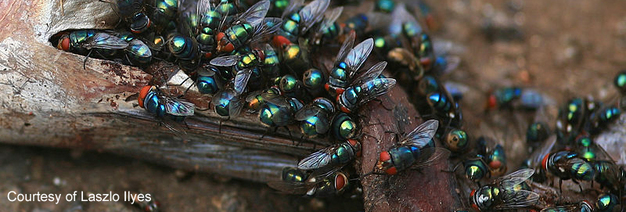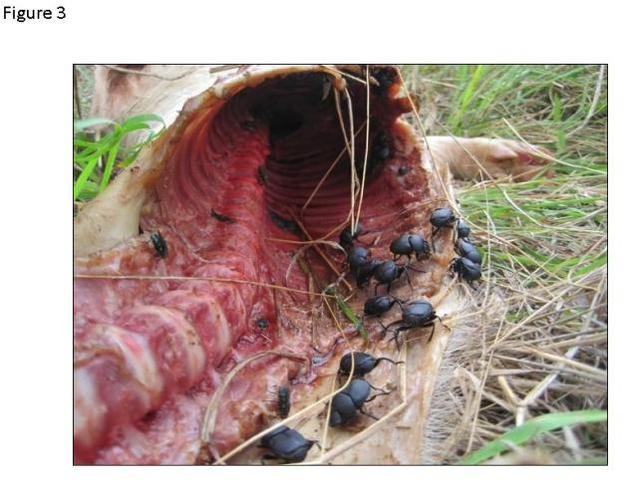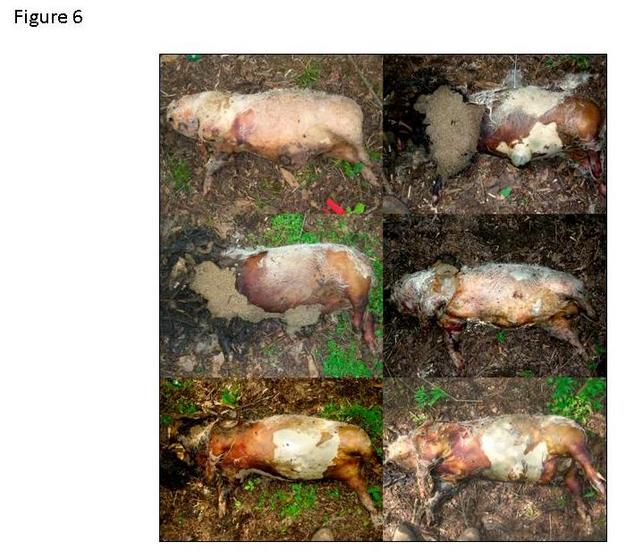« Prev Next »

Carrion, or the remains of dead animals, is something that most people would like to avoid — it is visually unpleasant, emits foul odors, and may be the source of numerous pathogens. Decomposition of carrion, however, provides a unique opportunity for scientists to investigate how nutrients cycle through an ecosystem. Many people might ask, "Why is this subject important?" Simply put, understanding carrion decomposition is important from both a basic and applied perspective. Carrion decomposition experiments allow us to better understand how ecosystems function so that we can more effectively manage natural environments. It also enhances our abilities to identify the factors influencing decomposition rates, and to solve the forensic mysteries surrounding the unexplained deaths of animals, including humans.
Key Players in Carrion Decomposition
Decomposition of animal carrion is achieved primarily through the activities of invertebrates, such as flies and beetles, and large scavengers, generally other vertebrates such as opossums, raccoons, and vultures. Microbes, such as bacteria and fungi, are also important for carrion decomposition.
Invertebrates
Flies

Carrion flies can locate a dead animal within minutes. Multiple females deposit eggs, or larvae, on a single animal, so hundreds or thousands of larvae can colonize a single carcass. The larvae grow and develop by feeding on the carrion, converting the animal tissue into their own body tissue (minus that used for larval respiration and excretion). After acquiring the necessary nutrients from the carcass, larvae often crawl substantial distances from the remains, burrow into the soil, enter a pupal stage, and emerge as adults. Development time from egg to adult varies by species, and is dependent on environmental conditions, especially temperature; it may require a little over a week, or take several months. Upon emerging, adults monitor the habitat for the next carrion resource (Figure 2). Carrion flies locate dead animals through a keen sense of smell; they can detect minute traces of decomposition odor in air currents.

Beetles

Depending on the species, beetles have different roles in the carrion food web. Many beetles feed on the remains, some are predators that feed on fly eggs and larvae that have colonized the carcass, and others feed on both. Beetles that feed on the remains are referred to as decomposers, while species that feed across multiple trophic levels (i.e., on the remains and on the other invertebrates) are called omnivores.
Vertebrates

Microbes
Upon death, digestive enzymes and other compounds produced by the body begin to chemically alter and degrade the remains (autolysis). Microbial communities, from the external surface and the gastrointestinal tract, which are kept in check while the animal is alive, are also free to initiate and participate in the decomposition of the animal. Putrefaction is the proliferation of bacteria, from within the body, after death. Bacteria use the macromolecules (e.g., proteins and carbohydrates) present in the animal tissue to grow and multiply and, in doing so, produce chemical byproducts such as ammonia, cadaverine, hydrogen sulfide, and putrescine. This process is evident by the putrid odor of these chemicals and by the discoloration of the body (blue, black, yellow, green, and red) as the tissue is degraded. As the carcass is consumed, the bacteria also produce large amounts of gases through fermentation. Fermentation produces volatile chemicals that attract many of the invertebrates and vertebrates that help decompose the remains.
Basic Research: Carrion and Ecosystem Function
Predators consume many animals, however, substantial numbers that are not consumed via predation are decomposed after dying of injury or natural causes. These resource pulses, or biological oases, are highly variable in space and time, and in size and duration. For example, the dead animal may be small, like a rat or pig, and be located in a densely inhabited terrestrial setting lasting only a few days in the summer, or as large as a whale on the cold, desolate ocean floor which requires more than 16 years to become skeletonized.Scientists are now beginning to identify common characteristics, and mechanisms, of resource pulse nutrient release across ecosystems. The decomposition of vertebrate carrion, directly and indirectly, affects soil and benthic chemistry, as well as the local flora and fauna. Nutrients diffuse from the carrion into the soil resulting in changes in pH, conductivity, and nutrient concentrations (e.g., nitrogen and phosphorus). These nutrients are incorporated into the surrounding habitat leading to changes in the plant and arthropod communities, in both species composition (structure) and their activities (function).
As vertebrate remains are ephemeral, typically lasting only a few days to a few weeks, and numerous necrophagous species feed on the same resource, organisms must evolve a strategy to exploit the remains before it is fully consumed by competitors. Some organisms develop more quickly when faced with limited nutrients, at the cost of reduced adult body size (and reproductive potential). Others take much longer to develop, risking starvation if the food source should be fully consumed before development is complete, but without sacrificing overall body size. Since organisms must optimize their behaviors (i.e., they cannot simultaneously maximize both developmental time and body size), competition creates a tradeoff for carrion-feeding organisms.
Life history traits, like developmental time and body size, are controlled by both genetic and environmental factors (i.e., nature vs. nurture). Some genotypes have relatively ‘fixed' phenotypes across all environments (e.g., individuals of some species may grow faster than others). Since tradeoffs are common in nature, many species have also evolved some degree of phenotypic plasticity, to maximize their fitness. Plasticity is when organisms alter their appearance or behavior (phenotype) in response to different environmental conditions. For example, flies may complete development at a small size when reared in carrion with high levels of competition, but may be much larger if reared in an environment with low levels of competition. In addition, distinct genotypes often express different phenotypes in the same environment. This genotype-specific response is known as a "genotype by environment" (GxE) interaction. Genotype by environment interactions can indicate adaptation to local environments when found in a comparison of populations where the phenotype involved increases fitness. For example, females with a larger body size may be able lay more eggs compared to smaller females, which will result in higher fitness for the larger females. GxE interactions for female body size would indicate environment-specific adaptation to those particular environmental conditions. Genetic, environmental, and GxE interaction effects on phenotypes can be assessed across different populations by evaluating reaction norms.Applied Research: Using Decomposition as a Forensic Tool
Decomposing remains can be viewed as nutrient packages (i.e., resource pulses) that, if left in the environment, will be recycled into the ecosystem. In the majority of cases, the organisms that colonize and break down the carcass into its respective nutrients do so in a predictable, sequential manner (Figure 2). A comprehensive understanding of this pattern of succession enables scientists to determine approximately how long an organism has been dead. Developmental data from primary colonizers are also useful for this purpose.Forensic entomology is an important, applied field of decomposition ecology, as the initial, and most prevalent, organisms that are attracted to, colonize, and decompose remains are the invertebrates. By comparing insect presence, their development, and abundance on the remains to known development patterns at different rearing temperatures, it is possible to estimate the post-colonization interval and provide a minimum postmortem interval (m-PMI) or time since death. The estimated m-PMI can then be used as evidence in legal proceedings.
Forensic entomologists are perhaps best associated with estimating m-PMIs for humans, when the time since death is unknown. These events most commonly occur when individuals die unexpectedly (e.g., murder). Accurately determining patterns of insect attraction to, and colonization of, human remains is important to accurately estimate m-PMIs, particularly when other evidence is contradictory or lacking. It must not be forgotten, however, that many non-human vertebrates also meet an untimely death. Many large vertebrates (e.g., bears, tigers, rhinoceros) are illegally killed on a routine basis for their body parts (e.g., paws, gallbladders, horns) (Figure 5). Evidence analyzed by forensic entomologists can help ensure the individual(s) responsible for the crime are convicted, by providing an m-PMI based on entomological evidence.

Further research on the environmental factors influencing the decomposition of vertebrate carrion is needed. Minimum postmortem interval estimates are based on a series of assumptions; if these assumptions are not true, or if they change over space and/or time, estimates may not be accurate. Forensic entomologists rely heavily on data from animal models, most commonly the decomposition of swine carrion (Figure 6), though it is possible to experiment on donated human remains at some field sites, such as Forensic Anthropology Centers at The University of Tennessee in Knoxville, Tennessee, Western Carolina University in North Carolina, or Texas State University and Sam Houston University in Texas. Ultimately, this research will increase our understanding of how the environment influences the decomposition process, and will reduce the error associated with m-PMI estimates for forensics.

Summary
An in-depth understanding of how natural carrion decomposition progresses, and how biological communities interact to recycle this resource into the ecosystem, is important from both basic and applied perspectives. Understanding the ecology of carrion decomposition greatly advances different fields of study, such as biogeochemistry, ecology, evolution, and forensic science.References and Recommended Reading
Amendt, J. et al. Best practice in forensic entomology-standards and guidelines. International Journal of Legal Medicine 121, 90-104 (2007).
Bass, B. & Jefferson, J. Death's Acre: Inside the Legendary Forensic Lab, The Body Farm, Where the Dead Do Tell Tales. New York, NY: G.P. Putnam's Sons, 2003.
Byrd, J. H. & Castner, J. L. eds. Forensic Entomology: The Utility of Arthropods in Legal Investigations, 2nd ed. Boca Raton, FL: CRC Press, 2010.
Conner, J. K. & Hartl, D. L. A Primer of Ecological Genetics. Sunderland, MA: Sinauer Associates, 2004.
DeVault, T. L., Rhodes, J. O. E. & Shivik, J. A. Scavenging by vertebrates: Behavioral, ecological, and evolutionary perspectives on an important energy transfer pathway in terrestrial ecosystems. Oikos 102, 225-234 (2003).
DeLong, E. F., Wickham, G. S., & Pace, N. R. Phylogenetic strains: Ribosomal RNA-based probes for the identification of microbial cells. Science 243, 1360-1363 (1989).
Delong, E. F. Microbial population genomics and ecology: The road ahead. Environmental Microbiology 6, 875-878 (2004).
Emmens, R. L. & Murray, M. D. The role of bacterial odours in oviposition by Lucilia cuprina (Wiedemann) (Diptera: Calliphoridae), the Australian sheep blowfly. Bulletin of Entomological Research 72, 367-375 (1982).
Fuller, M. E. The insect inhabitants of carrion: A study in animal ecology. Council for Scientific and Industrial Research 82, 1-63 (1934).
Gunn, A. Essential Forensic Biology, 2nd ed. Chichester, UK: John Wiley and Sons, 2009.
Haskell, N. H. & Williams, R. E. eds. Entomology & Death: A Procedural Guide. Clemson, SC: Forensic Entomology Partners, 2008.
Janzen, D. H. Why fruits rot, seeds mold, and meat spoils. The American Naturalist 111, 691-713 (1977).
Naganuma, T., Wada, H. & Fujioka, K. Biological community and sediment fatty acids associated with the deep-sea whale skeleton at the Torishima Seamount. Journal of Oceanography 52, 1-15 (1996).
Parmenter, R. R. & MacMahon, J. A. Carrion decomposition and nutrient cycling in a semiarid shrub-steppe ecosystem. Ecological Monographs 79, 637-661 (2009).
Payne, J. A. A summer carrion study of the baby pig Sus scrofa Linnaeus. Ecology 46, 592-602 (1965).
Payne, J. A. A Comparative Ecological Study of Pig Carrion Decomposition and Animal Succession with Special Reference to the Insects, PhD Dissertation, Department of Entomology, Clemson University, Clemson, SC, 1967.
Payne, J. A., King, E. W. & Beinhart, G. Arthropod succession and decomposition of buried pigs. Nature 219, 1180-1181 (1968).
Tomberlin, J. K. & Adler, P. H. Seasonal colonization and decomposition of rat carrion in water and on land in an open field in South Carolina. Journal of Medical Entomology 35, 704-709 (1998).
Tomberlin, J. K., Wallace, J. R. & Byrd, J. H. Forensic entomology: Myths busted! Forensic Magazine October/November, 10-14 (2006).
Tomberlin, J. K. et al. Basic research in evolution and ecology enhances forensics. Trends in Ecology & Evolution 26, 53-55 (2011).
Tomberlin, J. K. et al. A roadmap for bridging basic and applied research in forensic entomology. Annual Review of Entomology 56, 401-421 (2011).
Townsend, A. R. et al. Human health effects of a changing global nitrogen cycle. Frontiers in Ecology and the Environment 1, 240-246 (2003).
Xu, J. P. Microbial ecology in the age of genomics and metagenomics: Concepts, tools, and recent advances. Molecular Ecology 15, 1713-1731 (2006).
Yang, L. H. & Rudolf, V. H. W. Phenology, ontogeny, and the effects of climate change on the timing of species interactions. Ecology Letters 12, 1-10 (2009).
Yang, L. H. et al. What we can learn from resource pulses. Ecology 89, 621-634 (2008).





























